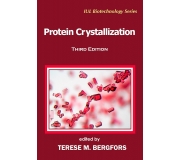Protein Crystallization (PCS-1)
 Click to enlarge |
|
The third edition includes three new chapters. Janet Newman has written on optimization of crystallization hits (Chapter 18) as a follow-up to her earlier chapter on screening (Chapter 15). Martin Caffrey describes state-of-the art methods for membrane protein crystallization (Chapter 19), and Soneya Majumdar the preparation and crystallization of macromolecular complexes (Chapter 20). The A-Z section is revised and expanded in this edition. It is a repository for short topics, 80% of them new for this edition. Finally, five “how to” protocols are included. The reader may also notice there are more color figures and images. Color is easier to include in e-books, so this third edition reflects that.
This edition, like the first two (published in 1999 and 2010), is intended to be a practical guide for the person in the wet lab. As editor, I aimed to provide an overview of topics, assure cohesion between the chapters and sections of the book, and to guide the reader to related topics in other chapters. Overlap of topics is intentional for the readers who are not reading the book cover to cover. Written by the best experts in protein crystallization from different countries.
Edited by Terese M. Bergfors, Dept. of Molecular Biology, Uppsala University, Sweden.
Book Details: Protein Crystallization
- Publisher : International University Line; 3rd edition (April 18, 2022)
- Language : English
- Paperback : 670 pages
- ISBN-10 : 0972077464
- ISBN-13 : 978-0972077460
- Item Weight : 3.11 pounds
To view Preface, please click button
To view Table of Contents, please click button
"Why is crystallization important? At different times, different aspects of protein crystallography have assumed the role of bottleneck. Thus at one time the bottleneck consisted of the lack of a methodology for structure determination, even if a sufficient number of diffraction intensitities were available for structure solution. With the advent of powerful methods for structure solution, the bottleneck shifted to the difficulty in obtaining crystals in sufficient number and of suitable quality to do the diffraction experiment. The present book is dedicated to the problem of describing current methods for protein crystallization and describing them as clear laboratory protocols." --Dr. Herbert A. Hauptman, 1985 Nobel Laureate in Chemistry
"I used the first edition as a graduate student. It was a perfect guide for protein crystallizers at all stages of their careers, providing methodical, clear explanations in lay terminology." --Dr. Lata Govada, Imperial College London
 Products
Products Manuals
Manuals



